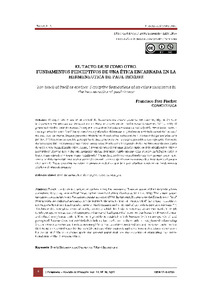Por favor, use este identificador para citar o enlazar este ítem:
https://repositorio.uca.edu.ar/handle/123456789/12401| Título: | El tacto de sí como otro : fundamentos perceptivos de una ética encarnada en la hermenéutica de Paul Ricoeur The touch of itself as another : perceptive foundations of an ethics incarnated in the hermeneutics of Paul Ricoeur |
Autor: | Díez Fischer, Francisco Martín | Palabras clave: | HERMENEUTICA; PERCEPCION; ETICA; ENCARNACION; Ricoeur, Paul, 1913-2005 | Fecha de publicación: | 2021 | Editorial: | Universidad Federal de Piauí. Departamento de Filosofía | Cita: | Díez Fischer, F. M. El tacto de sí como otro : fundamentos perceptivos de una ética encarnada en la hermenéutica de Paul Ricoeur [en línea]. Pensando : Revista de filosofía. 2021, 12 (26). doi: 10.26694/pensando:v12i26.12655. Disponible en: https://repositorio.uca.edu.ar/handle/123456789/12401 | Resumen: | Resumo: O toque não é um assunto central na hermenêutica contemporânea. No entanto, alguns dos intérpretes consideram-no um termo-chave na ética hermenêutica de Paul Ricoeur (Contreras, 2011 e 2018). O presente artigo examina o toque em seu trabalho. Soi-méme comme un autre (1990). Neste texto, Ricoeur usa a palavra francesa "tato" (toque) com dois significados diferentes. 1 °) Refere-se à virtude moral de "ter tato" no trato com os outros. Ele sugere que é uma virtude fundamental no início e no final do caminho para a sabedoria prática. 2 °) Refere-se ao sentido percertual do tato, graças ao qual o corpo é percebido como nosso próprio corpo. Por meio da percepção tátil acessamos e nos apropriamos desse fundo carnal de passividade que fundamenta sua teoria da ação e do cumprimento ético dela. Agora, é possível estabelecer uma ligação entre os dois significados, ético e perceptivo? Ricoeur não estabelece esse vínculo em sua obra. Portanto, existe apenas uma relação metafórica entre o toque como virtude e o toque como significado? Ou melhor, pode ser considerado um só e mesmo toque, aquele que, sendo e sentido essencial para a vida sensível e carnal, torna tangível e inevitável a exortação ética para a vida social? Essas questões norteiam o presente artigo, que tem por objetivo elucidar os fundamentos hápticos da ética ricoeuriana. Abstract: Touch is not a central subject in comtemporany hermeneutics. However, some of the interpreters have considered it as a key term in Paul Ricoeur´s hermeneutical ethics (Contreras, 2011 and 2018). The present paper examines touch in his work. Soi-méme comme un autre (1990). In this text, Ricoeur uses the French word "tact" (touch) with two different meannings. 1°) He refers to the moral virtue of "being tactful", in dealing with others. He suggests that it is a fundamental virtue at the beginning and at the end of the path to practical wisdom. 2°) It refers to the percertual sense of touch, thanks to which the body is perceived as our own body. Through tactile perception we access and appropriate that carnal background of passivity that bases his theory of action and ethical compliance with it. Now, is it possible to establish a link between both meanings, ethical and perceptual? Ricoeur does not establish that link in his work. So, is there only a metaphorical relationship between touch as virtue and touch as meaning? Or rather, can it be consiidered one and the same touch, the one that, being and essential sense for the sensible and carnal life, makes tangible and inescapable ethical exhortation for social life? These questions guide the present paper that has the objective of elucidating the haptic foundation of the Ricoeurian ethics. |
URI: | https://repositorio.uca.edu.ar/handle/123456789/12401 | ISSN: | 2178 843X | Disciplina: | FILOSOFIA | DOI: | 10.26694/pensando:v12i26.12655 | Derechos: | Acceso abierto | Fuente: | Pensando : Revista de filosofía. 2021, 12 (26) |
| Aparece en las colecciones: | Artículos |
Ficheros en este ítem:
| Fichero | Descripción | Tamaño | Formato | |
|---|---|---|---|---|
| tacto-si-como-otro.pdf | 5,94 MB | Adobe PDF |  Visualizar/Abrir |
Visualizaciones de página(s)
175
comprobado en 27-abr-2024
Descarga(s)
436
comprobado en 27-abr-2024
Google ScholarTM
Ver en Google Scholar
Altmetric
Altmetric
Este ítem está sujeto a una Licencia Creative Commons

